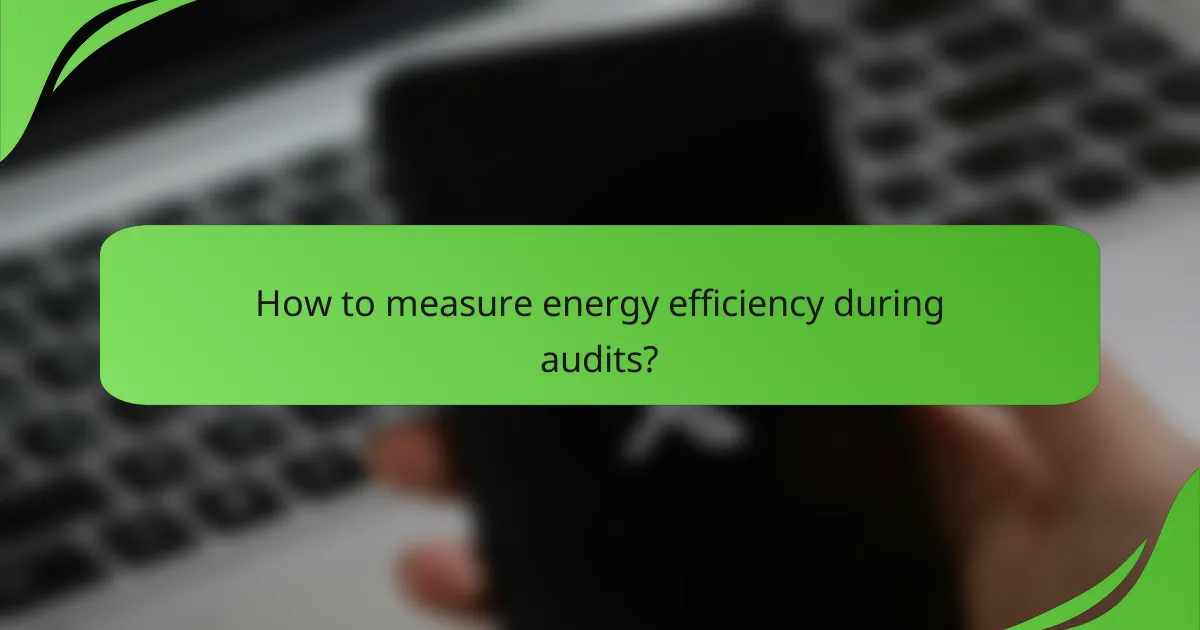Key metrics in energy audits play a crucial role in evaluating energy efficiency, cost savings, and environmental impact. By measuring various factors, organizations can identify inefficiencies and opportunities for improvement, enabling informed energy management decisions. Effective analysis techniques further enhance insights, allowing for comparative benchmarking and trend analysis to drive energy efficiency initiatives.

What are the key metrics in energy audits?
The key metrics in energy audits include various measurements that help assess energy efficiency, cost savings, environmental impact, and overall performance of energy systems. Understanding these metrics allows organizations to identify opportunities for improvement and make informed decisions regarding energy management.
Energy consumption analysis
Energy consumption analysis involves measuring the total energy usage of a facility over a specific period. This metric helps identify patterns in energy use, peak consumption times, and areas where energy is wasted. By comparing current usage against historical data or industry benchmarks, organizations can pinpoint inefficiencies.
To conduct an effective analysis, consider using sub-metering to track energy use in different areas or systems. This granular data can reveal which equipment or processes consume the most energy and require attention.
Cost savings potential
Cost savings potential refers to the financial benefits that can be achieved through energy efficiency improvements. By analyzing energy bills and identifying high-cost areas, organizations can estimate potential savings from upgrades or behavioral changes. This metric is crucial for justifying investments in energy efficiency projects.
Common strategies to enhance cost savings include upgrading to energy-efficient appliances, improving insulation, and implementing smart energy management systems. A well-structured energy audit can provide a clear outline of expected savings, often expressed as a percentage of total energy costs.
Carbon footprint assessment
A carbon footprint assessment measures the total greenhouse gas emissions associated with energy consumption in a facility. This metric helps organizations understand their environmental impact and identify opportunities to reduce emissions. It is increasingly important for companies aiming to meet sustainability goals or comply with regulations.
To conduct a carbon footprint assessment, consider using established calculators or software that can quantify emissions based on energy sources and consumption patterns. Focus on reducing reliance on fossil fuels and increasing the use of renewable energy sources to lower the overall carbon footprint.
Equipment efficiency ratings
Equipment efficiency ratings indicate how effectively energy is used by specific devices or systems. Common metrics include the Energy Efficiency Ratio (EER) for cooling systems and the Annual Fuel Utilization Efficiency (AFUE) for heating systems. Higher ratings typically correlate with lower energy consumption and costs.
When evaluating equipment, look for ENERGY STAR certifications or similar labels that signify superior efficiency. Regular maintenance and timely upgrades can help maintain or improve these ratings, ensuring optimal performance and energy savings.
Building envelope performance
Building envelope performance assesses how well a building’s exterior (walls, roofs, windows, and doors) retains heat and cool air. A well-performing envelope minimizes energy loss, leading to lower heating and cooling costs. Key metrics include insulation levels, air leakage rates, and thermal performance of windows.
To improve building envelope performance, conduct a thorough inspection and consider air sealing, adding insulation, or upgrading windows to energy-efficient models. Utilizing tools like blower door tests can help identify leaks and areas needing improvement.

How to measure energy efficiency during audits?
Measuring energy efficiency during audits involves assessing various factors that contribute to energy consumption in a building. Key methods include using energy monitoring tools, conducting thermal imaging tests, and performing blower door tests to identify inefficiencies and areas for improvement.
Using energy monitoring tools
Energy monitoring tools track real-time energy usage, helping identify patterns and anomalies in consumption. These tools can include smart meters and software applications that provide detailed insights into energy performance.
When selecting energy monitoring tools, consider their compatibility with existing systems and the granularity of data they provide. Many tools can help pinpoint high-energy usage periods, allowing for targeted interventions to improve efficiency.
Conducting thermal imaging tests
Thermal imaging tests use infrared cameras to detect heat loss in buildings, revealing areas where insulation may be inadequate. This method is particularly effective for identifying air leaks around windows, doors, and other openings.
During a thermal imaging test, it is essential to conduct the assessment under specific conditions, such as a significant temperature difference between the inside and outside. This ensures accurate readings and helps prioritize areas for insulation improvements.
Performing blower door tests
Blower door tests measure a building’s air leakage by creating a pressure difference between the inside and outside. This process helps quantify how much air escapes, indicating the effectiveness of insulation and sealing.
To perform a blower door test, a calibrated fan is installed in an exterior doorway, and the building is depressurized. The results can guide necessary improvements, such as sealing gaps or enhancing ventilation systems, to boost overall energy efficiency.

What analysis techniques enhance energy audit insights?
Effective analysis techniques during energy audits can significantly improve insights and drive energy efficiency. Key methods include comparative benchmarking, trend analysis over time, and scenario modeling, each providing unique perspectives on energy consumption and potential savings.
Comparative benchmarking
Comparative benchmarking involves evaluating an organization’s energy performance against similar entities or industry standards. This technique helps identify gaps in efficiency and highlights best practices that can be adopted.
To implement benchmarking, gather data on energy usage from comparable facilities, focusing on metrics such as energy intensity (energy use per square meter) and operational hours. This allows for a clear comparison and can reveal opportunities for improvement.
Common pitfalls include comparing dissimilar facilities or failing to account for variables like climate or operational differences. Ensure that the benchmarks are relevant and reflect similar operational contexts.
Trend analysis over time
Trend analysis over time examines energy consumption patterns, helping to identify fluctuations and long-term changes in usage. This technique is crucial for understanding how operational changes or seasonal variations affect energy efficiency.
To conduct trend analysis, collect historical energy data over several months or years. Look for patterns such as peak usage times or seasonal spikes, which can inform strategies for reducing energy waste during high-consumption periods.
Be cautious of drawing conclusions from short-term data, as they may not accurately represent overall trends. Aim for a minimum of one year of data to capture seasonal variations effectively.
Scenario modeling
Scenario modeling allows organizations to simulate different energy usage scenarios based on various operational changes or investments in efficiency technologies. This technique helps predict potential savings and impacts on energy consumption.
To create effective models, define variables such as changes in equipment, occupancy levels, or energy prices. Use software tools to simulate these scenarios and analyze the outcomes, which can guide decision-making on energy projects.
When modeling, ensure that assumptions are realistic and based on credible data. Avoid overly optimistic projections that do not account for potential operational challenges or market fluctuations.

What are the best practices for energy audit reporting?
Best practices for energy audit reporting focus on clarity, actionable insights, and effective data visualization. These elements ensure that stakeholders can easily understand findings and implement necessary changes to improve energy efficiency.
Clear metric presentation
Clear metric presentation is essential for effective energy audit reporting. Use straightforward language and avoid technical jargon to ensure all stakeholders can comprehend the data. Metrics should be organized logically, often starting with overall energy consumption followed by specific areas of concern.
Consider using tables or bullet points to summarize key metrics, such as energy usage per square meter or cost savings potential. This format allows for quick comparisons and highlights critical information at a glance.
Actionable recommendations
Actionable recommendations should directly stem from the metrics presented in the audit. Each recommendation must be specific, feasible, and prioritized based on potential impact and cost. For example, suggest upgrading to energy-efficient lighting or improving insulation in high-energy-use areas.
Include estimated costs and potential savings for each recommendation to help stakeholders make informed decisions. Providing a timeline for implementation can also enhance the practicality of the recommendations.
Visual data representation
Visual data representation enhances understanding and retention of audit findings. Use charts, graphs, and infographics to illustrate trends, comparisons, and key metrics. For instance, a bar chart can effectively show energy consumption before and after implementing recommendations.
Ensure that visuals are clear and labeled appropriately. Color-coding can help differentiate between various data sets, making it easier for stakeholders to identify areas needing attention. Aim for simplicity to avoid overwhelming the audience with too much information at once.

What tools are essential for energy audits?
Essential tools for energy audits include energy management software, data loggers, and energy modeling software. These tools help assess energy consumption, identify inefficiencies, and provide actionable insights for improvement.
Energy management software
Energy management software is crucial for tracking and analyzing energy usage across facilities. It consolidates data from various sources, allowing for real-time monitoring and reporting on energy consumption patterns.
When selecting energy management software, consider features like user-friendliness, integration capabilities with existing systems, and compliance with local regulations. Popular options include Energy Star Portfolio Manager and Schneider Electric’s EcoStruxure.
Data loggers
Data loggers are devices that record energy consumption data over time, providing valuable insights into usage trends. They can measure parameters such as voltage, current, and temperature, helping identify peak usage times and potential savings opportunities.
Choose data loggers that offer adequate storage capacity and battery life for your specific needs. For example, a logger with a capacity of several months of data storage can be beneficial for long-term monitoring.
Energy modeling software
Energy modeling software simulates energy consumption in buildings, allowing for detailed analysis of energy efficiency measures. This software helps predict the impact of various upgrades, such as insulation improvements or HVAC system changes.
When using energy modeling software, ensure it aligns with industry standards like ASHRAE or LEED. Tools like eQuest and EnergyPlus are popular choices for creating accurate energy models.

How do local regulations impact energy audits?
Local regulations significantly influence energy audits by establishing the standards and requirements that must be met. These regulations can dictate the scope of the audit, the methodologies used, and the reporting formats required to ensure compliance with energy efficiency goals.
Compliance with energy codes
Compliance with energy codes is essential during energy audits as these codes set the minimum efficiency standards for buildings. Auditors must familiarize themselves with local energy codes, which can vary widely by region and often include specific requirements for insulation, HVAC systems, and lighting.
For instance, in the United States, the International Energy Conservation Code (IECC) is commonly adopted, while in Europe, the Energy Performance of Buildings Directive (EPBD) guides compliance. Auditors should check if their local jurisdiction has adopted these or similar codes to ensure their audits meet the necessary legal standards.
To ensure compliance, auditors should create a checklist of relevant codes and standards applicable to the specific building type and location. This checklist can help identify potential areas of non-compliance and guide necessary improvements, ultimately leading to better energy performance and reduced operational costs.
